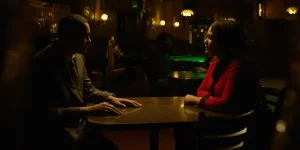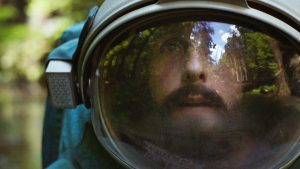
This article contains light spoilers for Trap.
It’s no spoiler to say that M. Night Shyamalan makes a cameo appearance in his latest movie Trap. After all, Shyamalan shows up in all of his movies, a tribute to his hero Alfred Hitchcock. But as much as he wants to follow in the footsteps of the master of suspense, Shyamalan has the heart of an ’80s schlockmeister.
For evidence, look no further than Trap. Yes, the film has a Hitchcock-worthy premise, in which suburban dad Cooper (Josh Hartnett) finds the pop concert he’s attending with his pre-teen daughter interrupted by police hunting a serial killer called the Butcher. The problem? Cooper is the Butcher, which audiences learn (well, audiences who didn’t watch the trailer or know the movie’s base premise) when he checks in on one of his victims via remote camera.
Trap has its tense moments, but its real fun comes from trashier bits, elements that feel straight out of The Stepfather or Friday the 13th Part Two. These base pleasures carry Trap through even when the tension fades. It’s a trick that Shyamalan has relied upon throughout his career.
At his best, M. Night Shyamalan is a pulpy b-movie movie director first, and everything else builds from his ability to wring pathos from shocking tales and unrealistic material.
The Slop Sense
Ask most people what they remember about The Sixth Sense. Some will immediately recite the line “I see dead people,” while others will recall seeing the big twist for the first time. Everyone else will refer to two distinct scenes: Mischa Barton throwing up and the guy with the back of his head blown out.
Those scenes stick in our heads for good reason. Shyamalan crafts them for maximum effect, overriding even the rules established earlier in the film. The camera traces along the roof of Cole’s tent, once a pseudo-sanctuary that could not be violated by spirits, to reveal Barton’s character Kyra inside, seconds before she spews. Shyamalan holds for a moment once the gunshot wound teen arrives but adds a music sting right when he turns around, accentuating the jolt of the gore.
Even when not dealing with such icky material, Shyamalan still directed scare scenes for ultimate creepiness. The shot of an alien walking out from behind a wall remains the standout moment in Signs. traumatizing to an entire generation of young moviegoers in the early 2000s. Despite its dour tone, Unbreakable contained upsetting material about an infant born with every bone shattered. The Village features a monster lurking around its 17th century-style settlement, while a grassy beast slaughters a haughty movie critic in Lady in the Water.
It’s not just the blood and guts that define Shyamalan’s work during his first successful phase. It’s also their unabashed silliness, the goofy plot points that don’t fly in serious movies but make perfect sense in a b-picture. If water kills a type of alien, why would those aliens come to a planet that’s mostly water? By that same token, how in the world can a human being like David Dunn be allergic to water?
The secret to Shyamalan’s early period was his ability to present this goofy, trashy stuff with the precision of a master filmmaker and find notes of pathos within the story. Even when people sometimes rolled their eyes at the forced twists, the salty/sweet combination of trash and emotion brought them back for more.
M. Night Goes Wrong
Shyamalan suffered a slow descent in the late 2000s and early ’10s, with some diehards sticking with him even through the self-congratulatory Lady in the Water. But no one could defend him through his two worst movies, The Last Airbender and After Earth.
All of these films went wrong in more or less the same way. They got the balance wrong.
The problems became unavoidable with Lady in the Water, which purported to tell a fairytale about the power of stories. As mentioned, Lady in the Water has its goofy, pulpy aspects, including monsters called Narfs and a guy with one overly-muscled arm. But Shyamalan buries the tripe under loads of self-important mumbo jumbo, including casting himself as the writer whose book will change the world for the better. Instead of building the movie around the fun stuff and letting the emotions come out later, Lady in the Water leads with the big ideas and acts embarrassed about its wonderful rubbish.
The problem gets worse in The Happening, The Last Airbender, and After Earth. At first glance, all three movies seem extremely pulpy. The Last Airbender adapts a wuxia-influenced Nickelodeon cartoon, After Earth has a high sci-fi premise about surviving dangerous beasts on a distant planet, and The Happening features grisly death after grisly death.
But none of those work because Shyamalan downplays the gross stuff for the sake of high ideals. In After Earth, which has a story credit for star Will Smith and a script credited to both Shyamalan and Gary Whitta, the tension comes not from dealing with scary beasts, but from protagonist Kitai Raige (Jaden Smith) stifling his fear. The cartoony excesses of The Last Airbender fall away behind overheated speeches, delivered by even good actors like Dev Patel in flat affect.
The most dumbfounding of these remains The Happening, which should work as pulp. The idea of plants forcing people to kill themselves makes for some absurd sequences, including a guy getting run over by his own lawn mower and a zookeeper allowing himself to be ripped apart by lions. Even a sequence in which an elderly woman shoots a kid feels played for shock more than it is tragedy. All of these moments work because of their preposterous material, to which Shyamalan brings his uncanny eye for composition.
But instead of celebrating his well-crafted junk, Shyamalan draws attention away from the pulp and toward undercooked big ideas. The script thinks that we’re interested in the romance between the leads, who would be flat characters even if played by actors better/more committed than Mark Wahlberg and Zooey Deschanel. It tries to say something about climate change, but thinks viewers are more interested in a big sequence in which characters run from the wind, more than any of the gory death scenes.
As the first half of his career shows, Shyamalan works when he gets away from big ideas. But he can never get away from the pulp. In fact, he shouldn’t get away from the pulp because that’s where he works best.
Back to the Trash, Back to the Top
Toward the climax of the 2015 found-footage Blumhouse flick The Visit, an elderly man drops his pants, pulls off his soiled adult diaper, and smears it onto the face of a preteen with debilitating germaphobia.
And that’s how M. Night Shyamalan relaunched his career.
While not all of the same quality, Shyamalan has had just as many great films in his comeback as he had during his first heyday. And all of them are pulpy at their core. Split and Glass involve superheroes and outlandish depictions of dissociative identity disorder. Old, of course, takes place on a beach that makes you old, while Knock at the Cabin includes scenes of bloody sacrifice.
Shyamalan never abandons his desire to say something profound in these films. Split wants to deal with issues of dealing with tragedy and Glass about community and belief, neither of which really land. Old and Knock at the Cabin, however, include beautiful depictions of the joy and pain of parenting.
However, the pathos works with the outrageous stuff instead of against it. In his best later movies Shyamalan remembers that he’s a pulp director first. In its best moments, Trap operates according to this principle, thanks to a remarkable performance by Hartnett and some of the best teleporting this side of Jason Voorhees.
Even if Trap doesn’t entirely work, it at least plays to Shyamalan’s strengths, proving that he’s finally come to embrace, and not bury, his wonderful pulpy heart.
Trap is now playing in theaters.
The post The Pulpy B-Movie Shyamalan of Trap Is the Best M. Night Shyamalan appeared first on Den of Geek.







